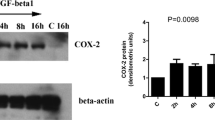Abstract
Background
We reported that nephrin is phosphorylated at Y1204 and Y1228 under normal conditions and that the phosphorylation is decreased in puromycin nephrosis and in human minimal change nephrosis. These results indicate that the phosphorylation of nephrin is important for maintaining normal podocyte function. However, little is known about the regulation of nephrin phosphorylation. Here, we investigated whether glucocorticoid, a drug used to treat glomerular diseases with proteinuria, might affect the phosphorylation of nephrin.
Methods
Human cultured podocytes transiently expressing human nephrin were treated with dexamethasone (Dex), and the phosphorylation of nephrin was determined by immunoblot with the anti-pY1228 antibody.
Results
Dex treatment for 24 h increased the phosphorylation of nephrin; this increased phosphorylation was inhibited by the glucocorticoid receptor antagonist but not by the mineral corticoid receptor antagonist. A shorter incubation time (30 min) did not increase the phosphorylation, and actinomycin D and cycloheximide treatments abolished the increased phosphorylation. The activation of Src-family kinases was correlated with nephrin phosphorylation, both of which were abolished by small interfering RNA (siRNA) treatment for serum/glucocorticoid-induced kinase 1 (SGK1).
Conclusions
These results clarify a novel action of glucocorticoid on nephrin phosphorylation through SGK1. Glucocorticoid treatment for human glomerulonephritis may exert its function by regulating the phosphorylation of nephrin.






Similar content being viewed by others
References
Kestila M, Lenkkeri U, Mannikko M, Lamerdin J, McCready P, Putaala H, et al. Positionally cloned gene for a novel glomerular protein—nephrin—is mutated in congenital nephrotic syndrome. Mol Cell. 1998;1:575–82.
Lehtonen S. Connecting the interpodocyte slit diaphragm and actin dynamics: emerging role for the nephrin signaling complex. Kidney Int. 2008;73:903–5.
Li H, Lemay S, Aoudjit L, Kawachi H, Takano T. SRC-family kinase Fyn phosphorylates the cytoplasmic domain of nephrin and modulates its interaction with podocin. J Am Soc Nephrol. 2004;15:3006–15.
Verma R, Wharram B, Kovari I, Kunkel R, Nihalani D, Wary KK, et al. Fyn binds to and phosphorylates the kidney slit diaphragm component Nephrin. J Biol Chem. 2003;278:20716–23.
Li H, Zhu J, Aoudjit L, Latreille M, Kawachi H, Larose L, et al. Rat nephrin modulates cell morphology via the adaptor protein Nck. Biochem Biophys Res Commun. 2006;349:310–6.
Jones N, Blasutig IM, Eremina V, Ruston JM, Bladt F, Li H, et al. Nck adaptor proteins link nephrin to the actin cytoskeleton of kidney podocytes. Nature. 2006;440:818–23.
Verma R, Kovari I, Soofi A, Nihalani D, Patrie K, Holzman LB. Nephrin ectodomain engagement results in Src kinase activation, nephrin phosphorylation, Nck recruitment, and actin polymerization. J Clin Invest. 2006;116:1346–59.
Lu W, Katz S, Gupta R, Mayer BJ. Activation of Pak by membrane localization mediated by an SH3 domain from the adaptor protein Nck. Curr Biol. 1997;7:85–94.
Rohatgi R, Nollau P, Ho HY, Kirschner MW, Mayer BJ. Nck and phosphatidylinositol 4,5-bisphosphate synergistically activate actin polymerization through the N-WASP-Arp2/3 pathway. J Biol Chem. 2001;276:26448–52.
Uchida K, Suzuki K, Iwamoto M, Kawachi H, Ohno M, Horita S, et al. Decreased tyrosine phosphorylation of nephrin in rat and human nephrosis. Kidney Int. 2008;73:926–32.
Zhang Y, Yoshida Y, Nameta M, Xu B, Taguchi I, Ikeda T, et al. Glomerular proteins related to slit diaphragm and matrix adhesion in the foot processes are highly tyrosine phosphorylated in the normal rat kidney. Nephrol Dial Transplant 2010;25:1785–95.
Jones N, New LA, Fortino MA, Eremina V, Ruston J, Blasutig IM, et al. Nck proteins maintain the adult glomerular filtration barrier. J Am Soc Nephrol. 2009;20:1533–43.
Tsutsui T, Nitta K, Yumura W, Nihei H. A stable transfected line of human glomerular epithelial cells. In Vitro Cell Dev Biol Anim. 1997;33:489–91.
Ma YC, Huang J, Ali S, Lowry W, Huang XY. Src tyrosine kinase is a novel direct effector of G proteins. Cell. 2000;102:635–46.
Xing CY, Saleem MA, Coward RJ, Ni L, Witherden IR, Mathieson PW. Direct effects of dexamethasone on human podocytes. Kidney Int. 2006;70:1038–45.
Shibata S, Nagase M, Yoshida S, Kawachi H, Fujita T. Podocyte as the target for aldosterone: roles of oxidative stress and Sgk1. Hypertension. 2007;49:355–64.
Ghosh MC, Baatar D, Collins G, Carter A, Indig F, Biragyn A, et al. Dexamethasone augments CXCR4-mediated signaling in resting human T cells via the activation of the Src kinase Lck. Blood. 2009;113:575–84.
Lowenberg M, Verhaar AP, Bilderbeek J, Marle J, Buttgereit F, Peppelenbosch MP, et al. Glucocorticoids cause rapid dissociation of a T-cell-receptor-associated protein complex containing LCK and FYN. EMBO Rep. 2006;7:1023–9.
Buttgereit F, da Silva JA, Boers M, Burmester GR, Cutolo M, Jacobs J, et al. Standardised nomenclature for glucocorticoid dosages and glucocorticoid treatment regimens: current questions and tentative answers in rheumatology. Ann Rheum Dis. 2002;61:718–22.
Buttgereit F, Straub RH, Wehling M, Burmester GR. Glucocorticoids in the treatment of rheumatic diseases: an update on the mechanisms of action. Arthritis Rheum. 2004;50:3408–17.
Acknowledgments
We thank K. Sasaki for technical assistance.
Conflict of interest
All the authors have declared no competing interest.
Author information
Authors and Affiliations
Corresponding author
About this article
Cite this article
Ohashi, T., Uchida, K., Uchida, S. et al. Dexamethasone increases the phosphorylation of nephrin in cultured podocytes. Clin Exp Nephrol 15, 688–693 (2011). https://doi.org/10.1007/s10157-011-0479-0
Received:
Accepted:
Published:
Issue Date:
DOI: https://doi.org/10.1007/s10157-011-0479-0




